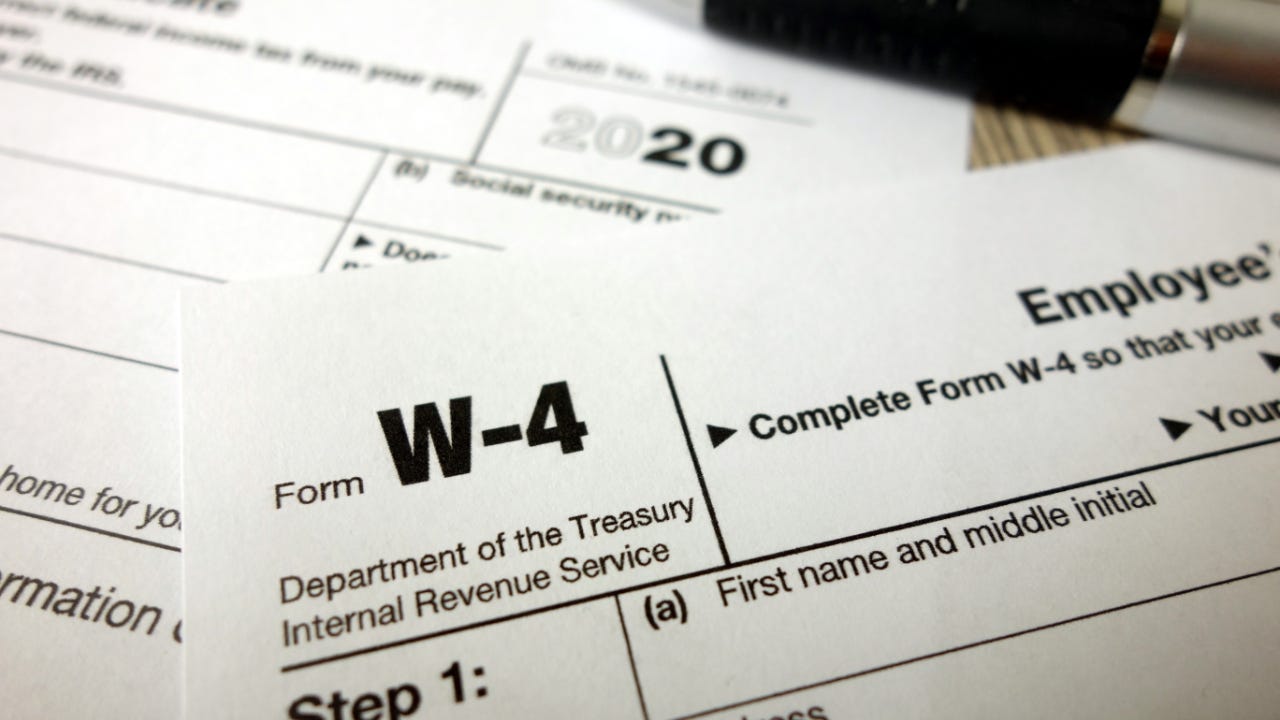Tax withholding definition: When and how to adjust your IRS tax withholding




Tax paid to the government by the payer of the income (not the recipient of the income) is called tax withholding. This is usually done by an employer by deducting a percentage of the income before paying it to the employee. It is possible to influence the amount withheld by filling out Form W-4, Employee’s Withholding Certificate, at any time of the year.The goal of adjusting tax withholding is to have just the right amount withheld — as close as possible to your actual tax liability. To have excess funds withheld may get you a big tax refund, but having less money withheld can give you more of your income to use for more necessary expenses without waiting for tax season.
Jump to a section:
- How tax withholding works
- When you should adjust your tax withholding
- How to adjust your tax withholding
How tax withholding works
The IRS requires employers to withhold a portion of each worker’s paycheck for federal taxes throughout the year. Without this built-in, pay-as-you-go mechanism in place, chances are high that much of the American population would not have the funds to cover their tax bill in mid-April, or even in mid-October if they were to file late.
Form W-4 is used to make sure that the employer is withholding the correct amount of funds for federal taxes. If less than the correct amount is withheld, you will owe money (and maybe an underpayment penalty) when filing your tax return, and if too much money is withheld, you will usually get a refund.
Form W-4 recently underwent a redesign to correspond with changes in tax law, courtesy of the Tax Cuts and Jobs Act of 2017. Currently, tax withholding is based on your filing status and the standard deduction for the year. If you itemize deductions, Form W-4 accounts for that, as well as number of dependents, household income, tax deductions and tax credits.
Steven Rodriguez, a partner at O’Connor & Rodriguez, PA in Miami Shores, Florida, recommends getting acquainted with the IRS’ Tax Withholding Estimator to help you come up with an accurate estimate of your tax obligation for the year. “Be sure to have a copy of your most current tax return handy because the new Form W-4 asks detailed questions based on your current and prospective tax return,” including specific line items, he says.
The IRS website answers some frequently asked questions about its tax withholding estimator, as well as Form W-4.
You will also need information about your spouse’s income or self-employment income, if applicable, and any other sources of income you may have. There is no threat to privacy when using the tool since you do not have to disclose any personal information, such as your name, Social Security number or bank account numbers, and the IRS does not retain any information you enter.
When you should adjust your tax withholding
There are a few circumstances that call for the adjustment of your tax withholding, including the start of a new job or if you are not satisfied with the tax withholding from last tax season. When starting a new job, your employer will require you to fill out the new Form W-4. If you are happy with your current W-4 with your present employer, you do not have to make changes to the withholding unless too much or too little was withheld.
Additionally, if you haven’t changed jobs since the Tax Cuts and Jobs Act was passed, you should update your W-4. Many people with withholding issues didn’t update their W-4 when the act was passed.
It is also a good time to fill out a new W-4 form when you experience major life events. For example:
- Your filing status changes – in the event of marriage, divorce or widowhood.
- You have or adopt a child.
- Your child turns 17 in a given tax year.
- You buy a home.
- Your income drops dramatically.
- You take part in the gig economy or get a second job.
- Your spouse gets a new job.
- You are unemployed for part of the year.
- You have paid off student loans.
- You have a major increase or decrease in pretax retirement savings via a 401(k) or deferred compensation plan.
How to adjust your tax withholding
If you’re single with just one job, no dependents and you take the standard deduction, then the new form is easy to manage. You just have to fill out the top part (Step 1) with your name, address, Social Security number and filing status. Then skip steps 2-4 and provide your signature and date on the bottom of the form (Step 5).
If you’re married and both you and your spouse are employed and make about the same amount of money, you might be able to get away with doing the same as above, plus checking the box in Step 2(c). Each spouse would have to do this on their respective Form W-4. If one spouse earns considerably more money than the other, then too much tax may be withheld.
If you earn income from several sources or have dependents, it gets more complicated.
Step 2 requires you to choose one of three ways to account for the various income sources:
- Use the IRS’online tool for best results.
- Fill out the Multiple Jobs Worksheet on page 3 of the form.
- Take the shortcut described earlier for two-income households with similar pay.
Step 3 takes into consideration tax credits you get when you claim dependents. Here you can also factor in education tax credits and the foreign tax credit, if you’re willing to get into the weeds of the instructions.
Step 4 accounts for deductions and unearned income, such as from interest, dividends and Social Security. A deductions worksheet for Step 4(b) on the form factors in itemized deductions, including mortgage interest, charitable contributions, medical expenses and state and local taxes. If you are taking the standard deduction, you can add such deductions as student loan interest and deductible IRA contributions on the worksheet. However, do not add the actual standard deduction amount to the total as this will result in an error.
If you have another job and you don’t want to share this fact with your employer, you can use the online tool to calculate your projected tax liability and then put an “extra withholding” amount in Step 4(c). This won’t raise suspicions since, as far as your boss is concerned, you might want to do that anyway simply to get a bigger tax refund.
If you didn’t owe tax last year and won’t owe tax this year because you expect to earn less than the standard deduction amount for your filing status, then you can simply fill out the top part of the form and write “exempt” in the space below line 4(c) and sign and date the form. This exercise will need to be repeated each year, as the exemption status is good for one year only.




